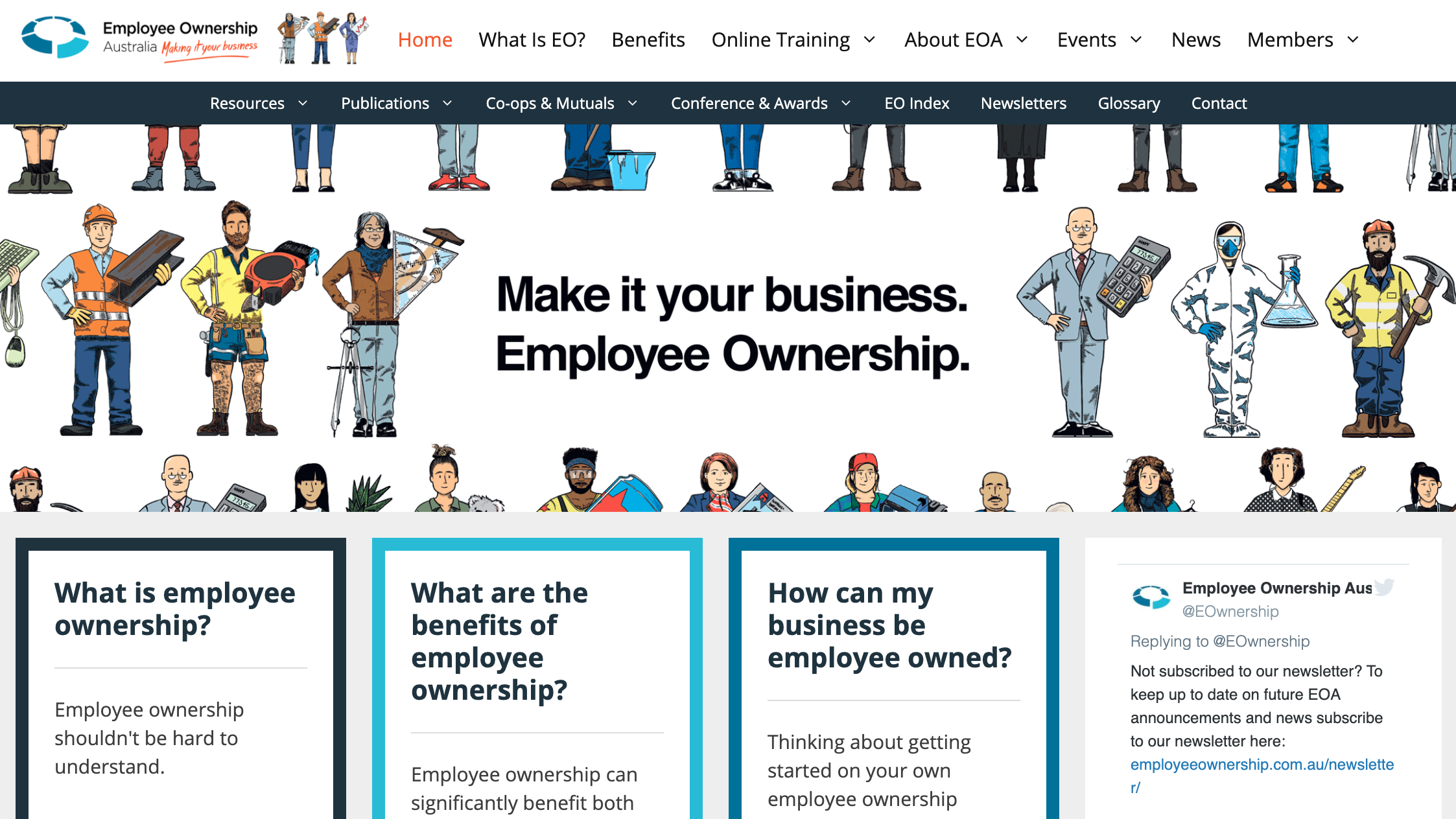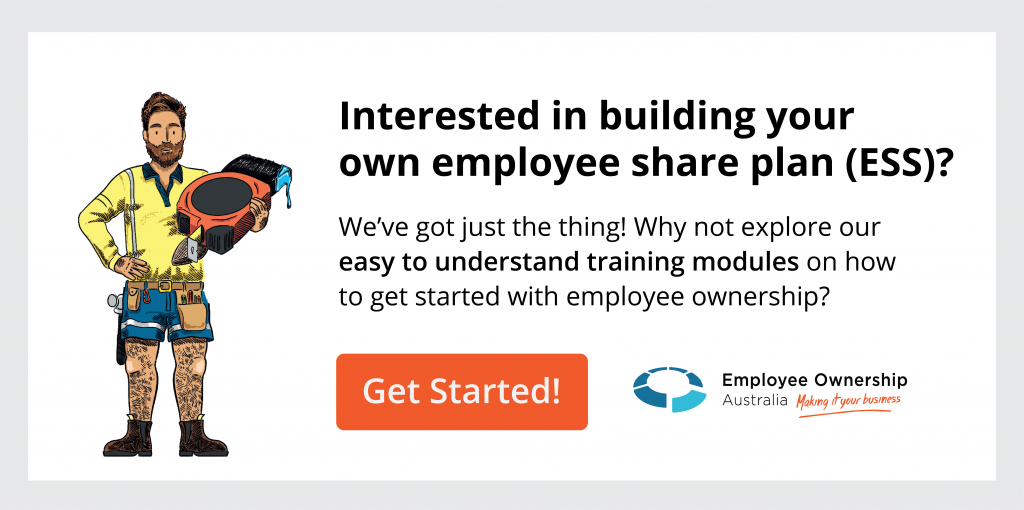What Is Employee Ownership?
Employee ownership is where a company gives its employees shares in the company in which they work.
This can involve part ownership or full ownership.
> Part Ownership: Where employees make up a percentage of the owners of the company.
> Full Ownership: Where the employees effectively own the company.
There are four pathways to be considered for employee ownership. These are Employee Ownership Trusts (EOTs), Employee Share Ownership Plans (ESOPs), employee share/options schemes and worker cooperatives.
Employee ownership can be used to assist with employee engagement, employee involvement, motivation and retention.
SMEs also use the vehicle of employee ownership for succession planning where the founder of the business is looking to retire.
Employees can acquire shares as part of an Employee Share Scheme or ESS (also known as employee share plans), with the shares either purchased or granted free of charge (gifted to employees). For two of our excellent stories on such ESS in larger companies in Australia, see The Strategies Driving The Growth And Success Of Origin Energy’s Employee Share Plan and Sharing In Success – How Participation In The Brambles Global MyShare Employee Share Plan Grew 5% During A Pandemic.
Purchase of shares can be financed by a loan, or by deductions from employee salary (salary sacrifice), bonuses, and profit shares. Some companies use rights or options at this employee level.
In simple terms, an ESS provides a way for employees to become part-owners or full owners of the business they work for.
Employee ownership can also take the form of cooperative and mutual enterprises. For information directed more specifically towards co-ops and mutuals please see our ‘co-ops & mutuals‘ tab in the menu options.
Note: Employee ownership is also sometimes referred to as ‘Employee Share Ownership’, ‘Employee Equity Ownership’, or ‘ESOP’.
For an excellent discussion on employee ownership policy and application, see the Interview by EOA Chair, Angela Perry with Graeme Nuttall, author of the “Nuttall Review of Employee Ownership” in the UK.
For more information on the language of employee ownership, please see our “Glossary of Terms” page.
For more on, see “How to choose the right employee share plan consultant“.
How is employee ownership different from other forms of remuneration?
The key difference between employee ownership and other forms of remuneration is that it transforms the relationship between an employee and their work, making an individual a part owner in their business.
This will often change the mindset and thinking of the individual and the way that they approach the work place – instead of ‘me’ the employee starts to think about ‘us’.
Research has shown that it can increase productivity by up to 5% when combined with employee engagement and involvement.[1]
Why would an employer implement an employee share plan?
There are a number of reasons why a company would implement an employee share plan.
> Create A Competitive Advantage: 90% of listed companies have some form of employee ownership. Regardless of whether you are an SME or a listed company it is likely that that you will be competing with listed peers.
> Reward, Incentivise & Motivate Staff: Become an employer of choice by providing real incentives for your employees.
> Improve Morale & Create Trust: Building trust with your employees allows you to foster a community amongst your workers, improving the working environment.
> Increase Productivity & Profitability: The productivity and profitability effects of ESS’s are most evident in those businesses where the majority of employees participate in an ESS, have some form of employee engagement or involvement and where the employees own a sizeable part of the company. It really comes down to common sense – if employees feel that they “belong” to the company in which they work, they will work better and the company’s performance will improve.
> Retirement Or Succession Planning: If a founder is looking to retire and has no obvious buyer or successor for the business, he or she may look to sell their business to the employees. Part of the driver for ESS’s being used in this way is that the philosophy and structure of the business is likely to remain intact after succession has taken place.
What are the common employee share plans used in Australia for all employees?
Employee share schemes can take a number of forms in Australia. The most common at the employee level are:
> $1,000 Tax Exempt Plan: This is where every employee is able to buy or get free shares in their employing company up to $1,000 per financial year. The employee must hold the shares for 3 years or until they leave the company, whatever happens sooner. Regardless of whether they leave or stay they will not lose the shares in the ESOP. The $1,000 is tax exempt provided the employee’s total taxable income is less than $180,000 per annum. This plan is covered by Division 83A, in the Income Tax Assessment Act 1997.
> $5,000 Salary/Bonus Sacrifice Plan: This is where an employee salary sacrifices some of their own salary/bonus to acquire shares in the company they work for. The amount is up to $5,000 per financial year and allows the employee to defer tax for up to 7 years – or 15 years post 1st July, 2015 – (depending on how long the shares are restricted for). Some companies also offer their employees company or matching shares, so for every share that the employee buys the company provides a free share. This plan is covered by Division 83A, in the Income Tax Assessment Act 1997.
> Loan Plans: This is where the company provides a loan to the employee to purchase shares in the company. The loan is usually interest-free and non-recourse or limited recourse (the only security for the loan is the shares, so if the share price falls only the shares are lost). This plan is outside the Income Tax Assessment Act 1997, Division 83A. This is a very common vehicle for unlisted companies.
For the latest on these employee share plans, you can view the following EOA Experts Panel Webinar: Employee Ownership – An update on Broad based Employee Share Plans (September, 2023).
Why do workers get into ESS’s?
In a recent Melbourne University study a group of employees were asked to rank what they felt were the most important elements of an employee share plan. The top 5 responses are listed below and provide an important insight into what employees consider as the most beneficial aspects of employee ownership.
1. Financial payoff (68%)
2. Fair treatment (67%)
3. A sense of community (59%)
4. Employee influence on management of the Company (42%)
5. Individual influence on decisions affecting daily work (38%)
See also “Employee ownership and the labour movement”.
For more information on what is described above, please see our “Glossary of Terms” page.
So in summary, employee share plans are used for:
> Succession Planning: When the owner (or owners) want to retire (or change their business direction) and need to sell an ESS can be an effective employee buy-out instrument. Also, the new model of the “Employee Ownership Trust” is rapidly developing around the world as a platform for transitioning ownership to employees through business succession.
> A Savings Vehicle: A major attraction ESOPs have for employees is that they accumulate savings and acquire and hold shares. Most plans have a long term focus of 3 – 7 years.
> Participation: Employee ownership gives employees a sense of community, facilitates employee engagement and involvement, and allows for employees to participate in the decision-making process of an organisation.
See also the following pages:
(i) Employee ownership – the advantages and disadvantages
(ii) Employee share plans – why you should participate
(iii) Employee ownership, participation and engagement – how to make it work
(iv) 8 Lessons From Successful Employee Owned Companies
(v) 7 reasons to consider employee ownership/ESOPs
(vi) A Visual Guide to Employee Ownership
See also “A Better Way of Doing Business”


